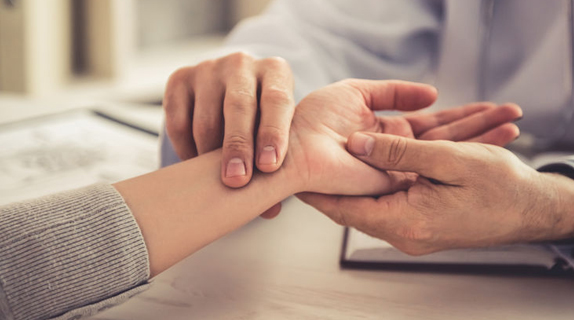Mr Mathew’s interests are in all pathology related to the hand and wrist from the adolescent to the older patients. Fractures in children and adults are also treated.
Clinical services
Educational services:
- Teaching for orthopaedic trainees
- Clinical education and update sessions for GPs
- Work experience for sixth formers with career guidance

Adults with:
- Fractures of small bones of the hand and wrist
- Fractures of the forearm
- Scaphoid fractures
- Ligament injuries
- Arthritis ( painful conditions) of the hand and wrist
- Tendon disorders ( trigger finger, Dequervains) in the hand and wrist
- Dupuytrens disease
- Tennis or Golfers elbow
- Infections in the hand and wrist
- Instability and ligament Injuries in the hand and wrist
- Fractures of the wrist
- Nerve compressions ( pins and needles ) in the hand and wrist
Tendon disorders
A tendon is a strong tissue that attaches a muscle to a bone. Tendons or the sheath that surrounds the tendon can get inflamed – this is usually referred to as tendinitis or tenosynovitis. These may occur form a variety of causes including overuse, inflammatory conditions like rheumatoid arthritis/ gout, secondary to infection or trauma. You may notice pain, swelling, tenderness and restriction of movement. Some are very specific and have names associated like Dequervains tenosynovitis and trigger finger , which are are two such common conditions.
Trigger finger/thumb – http://www.bssh.ac.uk/patients/conditions/18/trigger_fingerthumb
De Quervain’s syndrome – http://www.bssh.ac.uk/patients/conditions/19/de_quervains_syndrome
Arthritis
The word arthritis is used to describe pain, swelling and stiffness in a joint or joints. Arthritis isn’t a single condition and there are several different types.Arthritis can make life tough by causing pain and making it harder to get about. The symptoms of arthritis can vary from week to week, and even from day to day. Many types, such as osteoarthritis and rheumatoid arthritis, are long-term conditions. They can affect the small joints in your fingers , thumb basal joints or bigger joints like your wrist.
Find our more: https://www.bssh.ac.uk/patients/conditions/24/basal_thumb_arthritis
Ganglions
Ganglion cysts are the commonest type of swelling in the hand and wrist. They contain a thick clear fluid and can arise a variety of structures
Find our more: https://www.bssh.ac.uk/patients/conditions/20/ganglion_cysts
What is hand therapy?
Find out more: https://www.bssh.ac.uk/patients/what_is_hand_therapy.aspx
Fractures and other injuries.
A fracture (break) can occur in any of the bones in the hand or wrist. Many of these can be managed without surgery with further help from a good hand therapist for guided rehabilitation. Some do however require surgery.
Find out more: https://www.bssh.ac.uk/patients/conditions/31/general_information_on_hand_fractures
Hand injuries are common and can involve a variety of structures such as the skin, tendons, nerves, blood vessels, bones and joints. As with fractures many injuries heal without surgery but some may require tailored intervention.
Find out more: https://www.bssh.ac.uk/patients/conditions/hand_injuries
Dupuytren’s disease
Dupuytren’s disease, also called Dupuytren’s contracture, is a benign thickening of the connective tissue, or fascia, of the palm and fingers. It usually starts with a tiny lump, called a nodule, in the palm that is often mistaken for a blister or callus. Eventually string like cords develop beneath the skin, and if the condition progresses the affected fingers are pulled towards the palm and cannot be straightened anymore, resulting in Dupuytren’s contracture
Find out more: https://dupuytrens-society.org.uk/information/
Nerve compressions:
Nerves extend from your brain and spinal cord, sending important messages throughout your body and are most vulnerable at places in your body where they travel through narrow spaces but have little soft tissue to protect them. Nerve compression often occurs when the nerve is pressed between tissues such as: bone, ligaments or tendons. If you have a trapped nerve your body may send you warning signals such as pain. Don’t ignore these warning signals.
Find out more : carpal tunnel syndrome: https://www.bssh.ac.uk/patients/conditions/21/carpal_tunnel_syndrome
Cubital tunnel syndrome: https://www.bssh.ac.uk/patients/conditions/22/cubital_tunnel_syndrome
